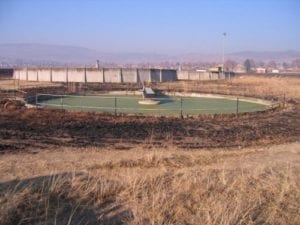The old Mpophomeni sewage treatment works, which was mothballed in 2001, is due to get a new lease on life in a major R160million sanitation upgrade project currently underway by consultants Royal HaskoningDHV.
“Mpophomeni township and treatment works is located on the western reaches of Midmar Dam and a number of problems led to its closure.The primary reason, hoever, was that it wasdischarging effluent that was progressively polluting the dam, a major water source for the KwaZulu-Natal region,” explains project principle, Peter Sibanda. “The works was replaced with a sewage pumping transfer scheme to Howick Treatment Works, which was upgraded to cope with the additional load. This entire infrastructure, including 11 km of pumping mains and sewers, has now reached maximum capacity,” he said. Set to add extra pressure to the current network, are plans by the uMngeni Municipality, in conjunction with the Ministry of Human Settlements, to develop housing projects in a number of areas within the municipality. “One of these is the Khayelitsha Social Housing Project located between Howick and Mpophomeni, intended to accommodate 1 900 houses, schools and commercial developments,” says Sibanda. The uMgungundlovu District Municipality, which took over the responsibility for water and sanitation in the uMngeni Municipal area in 2009, arranged for consulting engineers SSI – now known as Royal HaskoningDHV – to carry out a feasibility study to review the upgrade of the Mpophomeni/Howick sewerage infrastructure. A key requirement of the Department of Water Affairs was that all sewage or final effluent was to be transferred downstream of Midmar Dam to eliminate any possibility of pollution of the water body.According to project manager Chris Hazelden, four alternatives have been reviewed and the most economical is to redevelop the Mpophomeni site as a treatment works. “The existing works has infrastructure that can be reused such as back up facilities that can store and subsequently recycle inflows for more than three days when power outages or breakdowns occur and, beyond that period, any spillages can be partly treated.
“We estimate that 80 000 man days of construction job opportunities will be created as well as some permanent job opportunities,” he says. “Capacity in the existing western main sewers and the Howick Treatment Works will be partly freed up for development in Howick; the Howick Treatment Works site has a limited area for future expansion and ultimately will only be able to service Howick itself,” adds Hazelden. The Mpophomeni Sanitation Scheme has recently been approved by the Department of Water Affairs and includes:- a 6 Mℓ/day treatment works for Mpophomeni, Khayelisha and 25% spare capacity for future expansion; the site has space to at least double its treatment capacity
- infrastructure to deliver sewage from Khayelisha
- two new main sewers within Mpophomeni plus some other smaller sewer refurbishments that will eliminate identified sewage pollution within the township
- effluent delivery systems, including an artificial wetland effluent polishing system at the Treatment Works and a subsidiary wetland system on the Merrivale Stream recommended and designed by independent water quality and wetland specialists.








